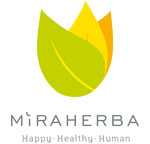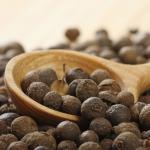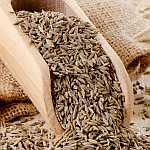.jpg)
Ayurveda medicated Oils
18.03.2011 | An article about the role, preparation and application of ayurvedic medicated oils. By Dr. Sajan Kumar. S
Artikel hier auch in deutsch lesen
The role of oils in Ayurveda:
Medicated oils occupy an important section of Ayurveda Pharmacology. In my state, Kerala, any small town shows up a few Ayurveda pharmacies and each having an average of 50 different medicated oils in stock. If one goes through the list of products presented by major manufacturers, up to 250 and more varieties could be found. Altogether more than 300 classical formulations are available in the market. Patented new formulations are not included here. Apart from these, there exist hundreds of formulations in the books which are not readily available in the market; but seldom prepared by physicians for treating specific illnesses.
While honey is considered as the most Kapha pacifying substance and Ghee, the most Pitha pacifying; Oil, particularly Sesame Oil is considered as the most Vata pacifying. This is making oil as the most ideal base for Vatha pacifying medicinal preparations. Considering oil applications, on the head it is applied as Pichu (piece of cotton or folded cotton cloth, soaked in medicated oil and applied on the apex of head), Thalam (mixed with some medicinal powder preparation in to a paste and applied on the apex of head), Sirodhaara, Sirovasthi are there. Urovasthi is keeping warm oil on the chest, Kateevasthi is keeping warm oil on the back, Thailavasthi is enema with medicated oil, Dhaara is pouring warm oil on a specific part or on the whole body, Abhyangam is general oil massage, Kabalam is holding oil in the mouth, in Snehapaanam, sometimes oils are drunken, in Karnapooranam, lukewarm oils are poured in and kept in the ear and in Utharavasthi, medicated oils are inserted in to genitals.
Applying oil on head, ears and feet is considered as of highest importance and it is advised to do on a daily basis. In ayurvedic view, daily Abhyanga tones the skin, prevents wrinkles, improves eyesight, promotes proper development of the body and enhances good sleep and the longevity of life.
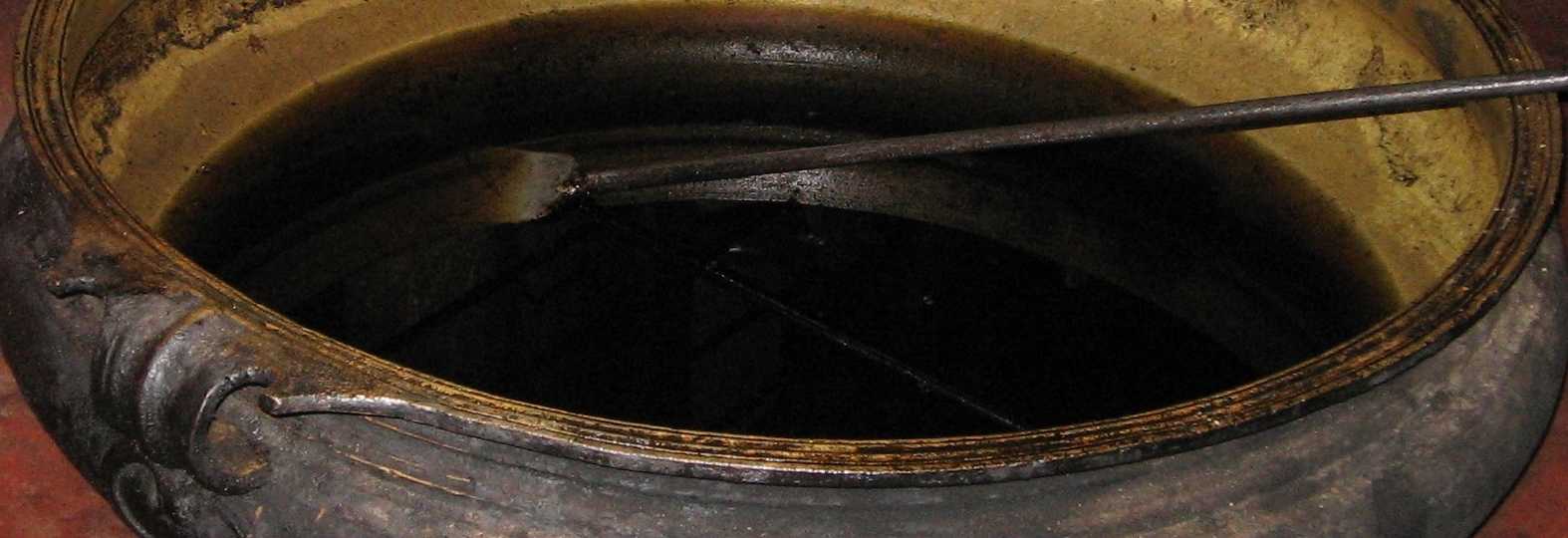
Philosophical background:
‘Snigdham’ is understood as the most significant property of oils, which is originally associated with element Jalam or Water. It is explained as the property associated with water which is converting brittle and dusty soil in to soft pliable mud. In the modern understanding, it is gravitational force, which is causing forms through binding together the particles. In view of the ancient understanding, this matches with the Bhoomi or Earth element. The difference, which snigdham makes with this concept of gravity is that, gravity leads to unity associated with stativity, while snigdham is providing unity supplemented by a certain range of mobility and flexibility as well. Through this conversion, the tendency of disintegration is reversed and integrity is gained; degenerative state is reversed in to fertile form and diversity is converged in to unity. These two phases represent the dualistic faces of everything in the nature. The force of Unification is the most basic cause of origin of life and its growth, while the force of diversification or separation is causing diseases, ageing, conflicts, separation, death and disintegration. Lipids are generally mentioned as ‘sneham’ in Ayurveda, which hints the property of snigdham. Sneham, in the common language means love. Love binds and keeps people together.
Everything existing had their origin in the past and certainly will face their end some day as well. The dual forces are the ultimate cause of creation and destruction. They interact throughout the life time in such a way that the constructive force dominates in the first half and the degenerative partner in the second half. There is no exception for this general principle, existing. Everything happening is rhythmic and cyclic and each complete cycle shows these two phases. The same is applicable to smaller units of time also. Daytime is diverging or opening up and makes us spend energy, making body and mind loose the snigdham and cold properties. Night and sleep do just the opposite and refills the lost strength and vigour. Similarly, the comparatively hot half of the year ending up with summer is taking out the strength and vitality of all living beings on Earth. In the starting of the next phase, it is showered back.
In India this is clearly identifiable through the arrival of Monsoon at the end of the exhausting hot summer, marking the starting of the wide agricultural activities of sowing and planting. These basic dual forces in the nature and the cosmos stay in various forms connected with all dual pairs in such a way that one of the forces dominates on one partner and the other on the counterpart. For instance, plants are more snigdham and cooling, while animals are dominated by dryness and heat. That makes plants, the constructive and animals, the de- constructive sides of the dualism from the metabolic point of view.
Snigdham is understood as a property, associated with water element and hence staying with all liquids, more or less. Among them, oils are considered holding this property in the ideal level which is matching the best for the maintenance and rejuvenation of human life. The dominating signs of Vatha, like dryness, lightness, etc, indicating degeneration, malnutrition, loss of vitality and content are leading to degenerative diseases like arthritis, in the abnormal way. From the middle age on, it gains the natural dominance, causing weakening of the body, wrinkles in the skin, etc. These signs indicate the necessity of oil intake and external applications. In the second half of life, the integrity of the physical body is getting weaker in comparison with the force of integration. This is making the necessity of oils more, when one gets older.
We could differentiate easily the solids, liquids and gases in the nature or in the body, which are examples of the basic Elements. But in the Ayurveda concept, they are inseparable in the subtle level. Each element in its subtle level is a mix with all others. Human body is neither extremely micro or macro. Even in that case, the solid, liquid and gaseous parts are almost inseparable. They are all practically existing everywhere in the body, more or less. Oxygen and Carbon dioxide, water, lymph, plasma, proteins, lipids, glucose, etc are all there everywhere, in each cell. It is the dynamicity which is actually making everything exist everywhere. In the static state, one object cannot be in the place occupied by another. But dynamicity makes it possible that the same space could be shared by two or more partners and the space which is enough for many, could be occupied by a single one, as well. In a way, the solid parts of the physical body are comparatively static and the liquid, gaseous and energy parts are gradually more and more dynamic. In another perspective, the anatomical side is relatively static and the physiological side is dynamic. From another point of view, the material part is relatively static and the energy part is dynamic.
Life is a mechanism balancing both; stativity and dynamicity. Kapha handles the relatively static part of the body and Vatha, the dynamic. Pitha is in the middle, which is holding the property of snigdham and stays as ‘dravam’, which should be understood as liquidity. The flow of a liquid is a balance or compromise in between stativity and dynamicity. It is similar to a whirling stone at the end of a string, which is in a way getting thrown outwards every moment and on the other way, never leaving the orbit, which is at a fixed distance from the centre always. It is travelling and stopping at the same time! Flowing liquids are tied up by the invisible strings of gravity, like the whirling stone by the string. The difference in comparison to the stone is that, the flow of liquids runs out of balance through a slight bias always towards the gravitational centre. Theoretically their flows can come to an absolute stop only at the centre of Earth’s gravity, if nothing is obstructing. On the other side, liquids are not like solids, completely bound by gravity. Liquids hold a certain degree of freedom to move and the limit of this freedom is that they cannot go upward or stay free without a support. This is expressed through the ‘saram’ or spreading property of Pitha. Thus liquids are compromising with stativity and dynamicity at the same time, with an affinity inclined towards stativity.
With life, water stays as the medium connecting everything with each other and as the base. Life is like a dynamic painting done on the canvas of water. On the other way, it is linking the stabile and dynamic principles of life. The dominance of the converging force in water element which is helping it to form spherical drops and making it flow downward always, is expressed through the snigdham property which is helping to bring and bind particles together. Convergent tendency is to be understood as a tendency orienting the stability of stativity at the gravitational centre. This tendency is creating solid matter and giving it stability. In Ayurveda view, it is Kapha promoting, since ‘sthiram’ (stable), ‘Guru’ (heavy), snigdham, ‘seetham’ (cold), ‘mandam’ (slowing down), etc are properties signifying Kapha. On the cosmic level, this dominance of the convergent force on the divergent causes materialisation or the creation and sustenance of matter. Divergence de- materialises everything in to dynamic energy forms. Element Vaayu represents the equal opposite of Water. Vaayu holds the property of divergence and uplifting; but not completely free from the effect of gravity. Just like water balances stability and mobility with a bias to the stability side, Vaayu is biased to the mobility side and that makes it induce dryness, lightness, dynamicity, porosity, etc and promote Vaatha. For the sustenance and growth of life, the converging or materialising force should be stronger and that makes the relevance of snigdham property and lipids in promoting growth, maintenance and rejuvenation and in the healing of degenerative diseases.
‘Ashtaanga Hrudaya’ explains that Abhyanga controls wrinkles (Ageing), helps the restoration of the body after physical exertion and exhaustion, and controls Vaatha. Applying simply sesame or coconut oil or medicated oils regularly is a tradition in Kerala. Oil application helps in dryness of the skin, splitting and breaking of hair and promotes general growth and vitality. Depending on the specific necessities and diseases, there exists a wide range of hair oils and oils for head also.
Management of Agni during Preparation:
Preparation of each medicated oil is having its own unique procedure. And the degree of cooking varies depending on the purpose and mode of application also. Generally the procedure of making medicated oils requires a liquid part, paste part and a powder part, apart from the oil. The liquid part can be more than one and it varies like, fresh herbal juices, decoctions, milk, yoghurt, water, etc. The paste can be grinded fresh herbs or dried herbs grinded with water. The powder part is usually aromatic ingredients and resins which hold volatile essences and that goes in nearly at the end of the procedure. Collection of the fresh ingredients, crushing, grinding and pressing the juice, preparation of decoction which goes hours of boiling until the whole quantity of water gets reduced to one fourth or one eighth, cooking of the oil until all water content vaporises, etc altogether makes the preparation of an oil much time and effort consuming.
When the water content in the mixture comes nearly to the end, the pasty sediments become more and more concentrated and reach a ‘muddy state’. From this level on, keen attention is needed to stop the cooking exactly at the specific level, considering the use. When the sediments reach a ‘waxy’ state, the oil is cooked enough for internal uses, like Snehapaana, Nasyam, Vasthy, etc. The ‘resin’ state indicates the level of cooking suitable for application on the skin. Hair oils need a bit more cooking; until the residue get completely dry and hard. This is mentioned as ‘sand’ level. Another indication of this state is the most intense fragrance of the aromatic principles coming out. The concept behind these different levels of cooking is connected with Agni, the fire which is digesting everything. Agni is the mediator in between all unions and separations; is the witness of all happenings and the cause of all transformations. In various forms, Agni exists in everything and changes everything all the time. In human body, the forms and intensity of Agni varies from one material to the other. Inner membranes are associated with relatively intense Agni and that makes the necessity of cooking not so much. Outer membranes need a bit more and hairs, the maximum. Just like we cook food just enough for the stomach, and stomach does the rest, each surface of the body digests oil in to the level needed and then only the essence is accepted and absorbed.
By negligence, if the oil is cooked more than the ‘sand level, the medicinal principles in it get burned. This oil is mentioned as ‘burned’ or ‘digested’ oil which is having no medicinal value, but toxic, causing the imbalance of all doshas. These levels of cooking are understood from the observation and understanding of action of Agni in everything. The sand level cooking is equivalent to the well ripe state of fruits, spreading intense aromas. The burned or digested state is similar to the putrefying stage of fruits. The same concept of different levels of cooking is applicable in food also. The various states of the residue mentioned, indirectly shows the different balances of the dual forces. In the ‘muddy state’, the unifying force is becoming stronger than the dispersing partner. In the following states, it is gradually gaining more power. Through the course of processing, gradually stativity is getting stronger, making flexibility lost. In the ‘Sand level’, flexibility is not any more left. The cracking and separation starts there. This is point at which the diversifying force starts dominating over the accumulating force.
These aspects were given very high significance in the former times. When there was no large scale manufacturing, mostly physicians were making small quantities for their own patients. The material of the vessel using and its thickness, the wood used, the hours taken and all, were given high importance. There were even particular wood used for preparing each medicated oil. And some stretched the procedure by putting off the fire, keeping only the ember in the last stage, which made the completion long an extra of 12 or 24 hours. The properties of milk, decoctions or medicated oils and ghees gets influenced and altered by the metals and alloys coming in contact with, according to Ayurvedic understanding. Some physicians of old times were using natural materials to the maximum extent, for instance, to filter the medicated oil after preparation, they used the natural filter covering the tender Coconut palm leaves before they get open!
Here is an example for an Ayurveda medicated oil, with its formulation, procedures of making, indications and the ways of application. Dhanwantharam Thailam is one of the most widely used medicated oil. The whole process of making this oil longs two days. It should be noted that 1.872.kg dried herbs, 8.6 litres of milk and 40.321 litres of water is used to prepare just 768. ml medicated oil! And the cooking goes on until 48.921 litres of water content completely evaporates. Altogether 43 herbs are used in it.
Dhanwantharam Thailam
‘Dhanwantharam’ means ‘from Dhanwanthari’, the god of Ayurveda; because it is supposed to be formulated by Dhanwanthari himself. ‘Thailam’ means ‘oil of Thilam’, which is sesam.
1. Oil : Sesame oil 768 ml
2. Liquid Part- 1: Milk 8.6 L
3. Powder part: Bala (Sida rhombifolia) Root powder- 1.152.Kg
Liquid Part- 2 (Decoction) Ingredients:
4. Hordeum vulgare (Yava-seeds) 300 g
5. Dolichos biflora (Horsegram) 300 g
6. Dasamoola (The ten roots), total 300 g coarse powder
a. Premna integrifolia
b. Aegle marmelos
c. Sterospermum suaveolens
d. Oroxylum indicum
e. Gmelina arborea
f. Tribulus terrestris
g. Desmodium gangeticum
h. Uraria picta
i. Solanum indicum(Two varities)
All these ingredients are added to 40.32 litres of water and boiled until reducing in to 11.52 L volume.
Paste Part: 4 g each
7. Fritillaria roylei (kakoli)
8. Polygonatum cirrhifolium (meda)
9. Polygonatum verticillatum (mahameda)
10. Malaxis acuminate (Jeevaka)
11. Malaxis muscifera (Rishabhaka)
12. Vigna na radiatpilosa (Mudga parni)
13. Vigna radiate (Masha parni)
14. Cedrus deodara (Devadaru)- the wood
15. Rubia cordifolia (Manjishta)whole plant
16. Santalum album (Sandal)
17. Sarisaparilla root (Hemidesmus indicus)
18. Saussuria lappa (Kushtam) root
19. Rocksalt
20. Fenugreek (Trigonella foenum-graecum)
21. Shilajith, a combination of minerals
22. Acorus Calamus (Vacha)
23. Acquillaria agallocha (Agaru), a very hard wood like rosewood
24. Boerhavia diffusa (Punarnava)
25. Withania somnifera (Ashwagandha) tuber
26. Asparagus racemoses (Sathavari) tuber
27. Ipoemoea digitata (Vidari) tuber
28. Glycyrrhiza glabra (Yashti) stem
29. Triphala (Terminalia chebula, Terminalia bellerica, Emblica officinale)
30. Commiphora myrrha (Vara rasam) resin
31. Anethum sowa (Sathahwa), whole plant
32. Elettaria cardamomum (Ela)
33. Cinnamomum camphora(Cinnamon)
34. Cinnamomum tamala (Pathram)
Processing of oil:
Decoction, milk, paste made from ingredients 6-33 and the oil are mixed together. This is taken in a brass vessel and kept on mild fire. Continuous stirring is done with a metallic spatula. It takes 5-6 hours to get the water content vaporised, leaving the oil with just the solid sediments left. When water content is getting reduced, gradually the sediments start to stick on the spatula. The level of cooking depends on the purpose, as mentioned earlier. At the end the vessel is taken away from the fire and allowed to cool down to atmospheric temperature. After filtering it is filled in air tight vessels.
Indications:
- Good for all Vata diseases,
- For women after delivery
- For children,
- People, who have got trauma in the marmas and bones,
- People, who are exhausted of suffering from some disease, for
reconvalescence.
- For old people, and people suffering of old age diseases,
because of its high rejuvenating properties.
- For certain kinds of fever
- Obstructions
- Psychic problems
- Schizophrenia
- Obstruction of urine
- Hernia
- Some Vaginal diseases
- Special effect on women and gynaecological problems
Applications:
All kinds of external and internal application, for instance;
Pichu, Shirovasti, Sirodhara, Abhyanga, Thalam,
For Nasyam (Dhanwantharam 101), Pichu for the chest in palpitation and heart diseases,
Kateevasti for the back, Urovasti in the position of heart, Vasti, Pizzichil, Njavarakizzi, Elakizhi, Vaginal Pichu, Uthara Vasti, Snehapanam, etc.
Repeated Processing:
Some of the medicated oils are available as repeatedly processed like, 7 times, 14 times, 21 times, 41 times and 101 times. These higher potencies are used in specific conditions and in small quantities. 7 to 41 times repeated oils are usually used for internal consumption. Together with or followed by liquid medicines, few drops or a half or one teaspoonful is advised to take. Mostly in Vaatha disorders such oils are prescribed. For Nasyam, Thalam, Utharavasthi and Pichu also these oils are used. 101 times repeated oils are usually for Nasyam. For Pichu, Thalam, etc also they are used rarely.
A 101 times repeated oil is made through repeating the whole process of the oil making 101 times, each time mixing the already processed oil with all ingredients afresh. It takes normally 4 to 6 months to prepare a particular 101 times medicated oil. It may seem like a herculian task altogether! But the results of such oils rationalise this great effort. For example, a Thalam on the apex of head with Ksheerabala- 101 could make an insomniac hypertensive patient calm down and sleep. A Pichu on chest with Dhanwantharam thailam repeated 7/ 14/ 21 times brings down excited heart beat (Palpitation) in to normal level within a time span of 10 to 20 minutes.
*© Copyrights Reserved
Contact:

Dr. Sajan Kumar Somarajan
Pappelweg 33
63741-Aschaffenburg
E- Mail: vedayurkerala@gmail.com
Web: www.ayurvaidya.de




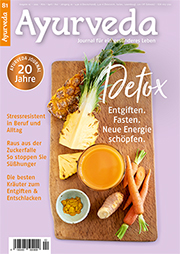


.png)

